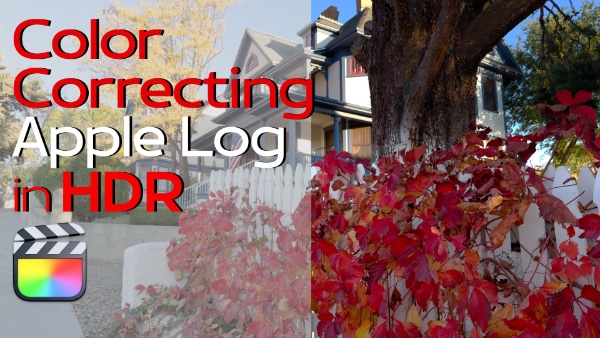Importing R3D RAW into Final Cut Pro X
In this “Under 5 Minutes” episode, Steve Martin will teach you a workflow for importing R3D RAW footage into Final Cut Pro X using the Red Apple Workflow software. You will also learn about transcoding the RAW footage into ProRes, proxy, or optimized media.
Welcome to Final Cut Pro X in under 5 minutes. I’m Steve from rippletraining.com. On the heels of last week’s episode on working with MXF files, this week I want to take a look at how to work with RED footage.
RED cameras record files in a format called R3D, that cannot be played back directly on many software based editing systems without first transcoding the files; a process often referred to as “de-bayering”.
The reason working with RAW files in the holy grail of image editing is that you have access to all the 16 bit camera data when you need to adjust the exposure or perform color grading on the image.
Before you can work with Raw media in Final Cut Pro X, you’ll need to download and install the Red Apple Workflow software available as a free download from Red.com.
On location, I typically transfer all the daily camera rolls to an external thunderbolt drive. Taking a quick peak inside, we can see the Red Digital Magazine folder containing all the RDC folders which contain the individual R3D files. Because of this complex file hierarchy, I find it’s much faster to import the files by dragging them into the Browser rather than using the Import window.
Select the Event and press Shift-Command-K to create a new keyword collection. I’ll name this Roll A1. Press Command-Comma to open preferences. Because R3D files are large and they already exist on my external drive, I’ll choose Leave Files in Place for my import option.
By choosing Create Optimized media, Final Cut Pro will generate Apple ProRes 4 by 4 media in order to maintain the maximum color and image fidelity of the RAW media for editing, grading and final output. If drive space is at a premium, you’ll want to choose Create proxy media. If you have a RED ROCKET card installed, Final Cut Pro will take advantage of this card’s dedicated chipset to reduce transcoding time.
The thing to remember is that transcoding or not, you always have access to the RAW media if you later decide you want to color grade your project in DaVinci Resolve.
If however, you decide to transcode now, you wont be able to manipulate the RAW image data within Final Cut Pro without first deleting the optimized and/or proxy media.
This is because the camera’s exposure and other profiles are baked into the transcoded media. I therefore suggest leaving the transcending options turned off because you can always do it later once you’ve given your footage a base grade.
I also recommend turning off any keyword tagging to prevent Final Cut Pro from creating a keyword collection from every clip that’s imported.
To import a camera roll, drag it onto the keyword collection that matches your roll number. Because a camera roll will often have more than just clips in it, Final Cut Pro will let you know which files it cannot import. Just ignore this window by clicking Continue Import.
With an R3D clip selected in the Event, press Command-4 to open the Inspector and click the Info button. Scroll down to the section labeled Available Media Representation. Here you can see that Final Cut Pro has access to the original RAW media, but Optimized and Proxy media have not been generated as indicated by the red symbols.
To modify the RAW metadata, click the Modify RED RAW Setting button to bring up a window of image manipulation options. The controls found in this window takes advantage of the RAW capabilities of the R3D media allowing you create a base grade for your footage prior to editing.
Changes you make here are completely non-destructive to the RAW media as you are only changing the instruction set of how to interpret and display the media.
You can alter the Color Space, Gamma, ISO and other global image settings. By changing the Gamma settings to Rec 709 for example, the image in the Viewer immediately reacts to the change and displays a clip that matches the gamma standards of HD television. You can also change the ISO, exposure, color temperature and many other settings. At any point you can revert to the original camera settings or neutral values using this pop up.
Keep in mind that this window is a much smaller subset of the controls you will find in the REDCINE-X software, but most of the core grading controls you would need access to are found right here. To apply the settings, click the Apply button.
Once you’re satisfied with your image changes, you can then transcode your files to optimized or proxy media to bake the changes into the media. In the Inspector, click the Generate Proxy button to create ProRes proxy media. Another option is to select the clip and choose > Transcode Media from the File menu, where you have the option to create both optimized and proxy media. I’m going to select Create proxy media and click OK. The background task window will show you the transcode in progress.
Once the optimized or proxy file has been generated, you wont be able to use the Modify settings window and you’ll be flagged about this with a dialog. In order to access the RED RAW settings again and make changes to the metadata, you’ll need to remove the optimized and/or proxy media by clicking the Continue button. Of course you’ll need to optimize or create proxy media again with the new settings in order to bake your changes into the file.
Click the Subscribe button below. If you have an idea, comment or suggestion, leave those below as well. Go to RippleTrainging.com for fast professional training on Final Fut Pro, Motion and DaVinci Resolve from industry professionals.
RED cameras record files in a format called R3D, that cannot be played back directly on many software based editing systems without first transcoding the files; a process often referred to as “de-bayering”.
The reason working with RAW files in the holy grail of image editing is that you have access to all the 16 bit camera data when you need to adjust the exposure or perform color grading on the image.
Before you can work with Raw media in Final Cut Pro X, you’ll need to download and install the Red Apple Workflow software available as a free download from Red.com.
On location, I typically transfer all the daily camera rolls to an external thunderbolt drive. Taking a quick peak inside, we can see the Red Digital Magazine folder containing all the RDC folders which contain the individual R3D files. Because of this complex file hierarchy, I find it’s much faster to import the files by dragging them into the Browser rather than using the Import window.
Select the Event and press Shift-Command-K to create a new keyword collection. I’ll name this Roll A1. Press Command-Comma to open preferences. Because R3D files are large and they already exist on my external drive, I’ll choose Leave Files in Place for my import option.
By choosing Create Optimized media, Final Cut Pro will generate Apple ProRes 4 by 4 media in order to maintain the maximum color and image fidelity of the RAW media for editing, grading and final output. If drive space is at a premium, you’ll want to choose Create proxy media. If you have a RED ROCKET card installed, Final Cut Pro will take advantage of this card’s dedicated chipset to reduce transcoding time.
The thing to remember is that transcoding or not, you always have access to the RAW media if you later decide you want to color grade your project in DaVinci Resolve.
If however, you decide to transcode now, you wont be able to manipulate the RAW image data within Final Cut Pro without first deleting the optimized and/or proxy media.
This is because the camera’s exposure and other profiles are baked into the transcoded media. I therefore suggest leaving the transcending options turned off because you can always do it later once you’ve given your footage a base grade.
I also recommend turning off any keyword tagging to prevent Final Cut Pro from creating a keyword collection from every clip that’s imported.
To import a camera roll, drag it onto the keyword collection that matches your roll number. Because a camera roll will often have more than just clips in it, Final Cut Pro will let you know which files it cannot import. Just ignore this window by clicking Continue Import.
With an R3D clip selected in the Event, press Command-4 to open the Inspector and click the Info button. Scroll down to the section labeled Available Media Representation. Here you can see that Final Cut Pro has access to the original RAW media, but Optimized and Proxy media have not been generated as indicated by the red symbols.
To modify the RAW metadata, click the Modify RED RAW Setting button to bring up a window of image manipulation options. The controls found in this window takes advantage of the RAW capabilities of the R3D media allowing you create a base grade for your footage prior to editing.
Changes you make here are completely non-destructive to the RAW media as you are only changing the instruction set of how to interpret and display the media.
You can alter the Color Space, Gamma, ISO and other global image settings. By changing the Gamma settings to Rec 709 for example, the image in the Viewer immediately reacts to the change and displays a clip that matches the gamma standards of HD television. You can also change the ISO, exposure, color temperature and many other settings. At any point you can revert to the original camera settings or neutral values using this pop up.
Keep in mind that this window is a much smaller subset of the controls you will find in the REDCINE-X software, but most of the core grading controls you would need access to are found right here. To apply the settings, click the Apply button.
Once you’re satisfied with your image changes, you can then transcode your files to optimized or proxy media to bake the changes into the media. In the Inspector, click the Generate Proxy button to create ProRes proxy media. Another option is to select the clip and choose > Transcode Media from the File menu, where you have the option to create both optimized and proxy media. I’m going to select Create proxy media and click OK. The background task window will show you the transcode in progress.
Once the optimized or proxy file has been generated, you wont be able to use the Modify settings window and you’ll be flagged about this with a dialog. In order to access the RED RAW settings again and make changes to the metadata, you’ll need to remove the optimized and/or proxy media by clicking the Continue button. Of course you’ll need to optimize or create proxy media again with the new settings in order to bake your changes into the file.
Click the Subscribe button below. If you have an idea, comment or suggestion, leave those below as well. Go to RippleTrainging.com for fast professional training on Final Fut Pro, Motion and DaVinci Resolve from industry professionals.






Any chance this same process could also be used to import RAW footage shot with Magic Lantern? Thanks!